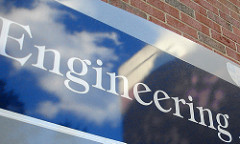Engineering activities for students
By Mary Bigelow
Posted on 2016-08-21
 If you’re concerned about how to teach engineering concepts in a K-12 environment, here are two resources that may be helpful.
If you’re concerned about how to teach engineering concepts in a K-12 environment, here are two resources that may be helpful.
The TeachEngineering project is designed “to make applied science and math come alive through engineering design in K-12 settings.” Concepts in life, earth and physical science are taught, connected, and reinforced through real-life problems or scenarios in student- and teacher-friendly formats. The site is searchable by grade level and topic with an option to search by NGSS standards. The lessons have been designed by university engineering faculty and teachers and build on what students learn in science. The lessons include objectives, background information, suggested activities, discussion questions, vocabulary, handouts, and suggested assessments and extensions. For example, here are some problem-solving lessons that could relate to a study of anatomy or the skeletal system:
- Grades 3-5 Our Amazing Skeleton
- Grades 6-8 Engineering Bones
- Grades 9-12 Bone Fractures and Engineering
Another source is IEEE’s TryEngineering. This is a portal of engineering activities and career information with lesson plans and engineering-related “games.” These can be searched by age level or topic. The lessons are PDF documents and also show alignment with curriculum frameworks (such as NGSS and Common Core).
The resources from both of these project are complete enough that even if you never studied engineering, you and your students can be involved in interesting problem-solving activities.
Photo: https://www.flickr.com/photos/lalunablanca/24455707/
Connecting with your students
By Mary Bigelow
Posted on 2016-08-18
 I meet with more than 100 students per day in my Earth science classes. As a relatively new teacher, I need suggestions on how to get to know them better including learning their names and interests in a timely manner. – L., Connecticut
I meet with more than 100 students per day in my Earth science classes. As a relatively new teacher, I need suggestions on how to get to know them better including learning their names and interests in a timely manner. – L., Connecticut
Students like to know teachers care about and respect them. Knowing their names is important from the start. When I would dutifully call out names on the first day, I predictably mispronounced a few or used a full name rather than a preferred nickname. Although some students found this hilarious, it embarrassed me and other students. So I started asking the students to introduce themselves, allowing me to annotate my list with phonetic spellings and nicknames. Regardless of how you feel about seating charts, I found them helpful at the beginning of the year to connect names and faces.
Identifying their interests can help personalize the science class. During the first week of school, ask students to write down information about themselves on index cards: name, birthday, nickname, interests/hobbies, school-related activities, out-of-school activities, (e.g., community organizations, sports teams, jobs), and other favorites and conversation-starters. I used a different color for each class, and each day I pulled a card and made a point to talk to that student informally. Other ideas from our colleagues:
- Steve Olenchek created a “Sciencebook” page for students to share more information about themselves (the page is similar to a Facebook page).
- Darci Sosa collects similar information in an online Google Docs survey. The results can be viewed in a spreadsheet. She sorts by any of the columns and uses information to group students with similar responses.
Your initial connections with students can promote participation and create a positive climate for learning.
Photo: http://www.flickr.com/photos/rongyos/2686415336/
 I meet with more than 100 students per day in my Earth science classes. As a relatively new teacher, I need suggestions on how to get to know them better including learning their names and interests in a timely manner. – L., Connecticut
I meet with more than 100 students per day in my Earth science classes. As a relatively new teacher, I need suggestions on how to get to know them better including learning their names and interests in a timely manner. – L., Connecticut

